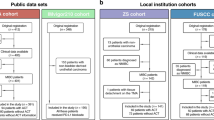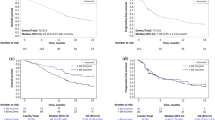Abstract
Purpose
CD19+ tumor-infiltrating B-cells (CD19+ TIB) play a crucial role in tumorigenesis, but their clinical relevance in muscle-invasive bladder cancer (MIBC) remains unknown. This study aimed to investigate the prognostic value of CD19+ TIB for post-surgery survival and adjuvant chemotherapy response in MIBC.
Experimental design
We assessed TIB by immunohistochemical staining of CD19 in 246 MIBC patients from Zhongshan Hospital and Shanghai Cancer Center. We evaluated the survival benefit of platinum-based chemotherapy according to CD19+ TIB. The mechanism underlying CD19+ TIB antitumor immunity was explored through the Cancer Genome Atlas (TCGA) dataset analysis and an in vitro Ag presentation assay.
Results
CD19+ TIB extensively infiltrated into the tumor stroma of MIBC. Adjuvant chemotherapy (ACT) led to a significantly increased benefit in the high CD19+ TIB MIBC patients (P = 0.003). In multivariate analysis, high CD19+ TIB MIBC patients had significantly longer OS with ACT in the discovery set (HR = 0.487, P = 0.038). TCGA gene expression analyses showed enrichment of adaptive immunity, T-cell-mediated immunity, and antigen-presentation signaling pathways in high CD19+ TIB MIBC patients. Moreover, CD19+ TIB co-localized with activated CD4+ TIT and expressed surface markers characteristic of antigen-presenting cells. Finally, an antigen-presentation assay demonstrated the antigen-presentation function of CD19+ TIB.
Conclusion
CD19+ TIB was identified as an independent prognostic factor, which could predict for post-surgery survival and platinum-based ACT benefits in MIBC. CD19+ TIB serve as antigen-presenting cells (APCs) to activate CD4+ TIT in the tumor environment of MIBC.





Similar content being viewed by others
Abbreviations
- ACT:
-
Adjuvant chemotherapy
- CD19+ TIB:
-
CD19+ tumor-infiltrating B-cell(s)
- GSEA:
-
Gene set enrichment analysis
- MIBC:
-
Muscle-invasive bladder cancer
- RC:
-
Radical cystectomy
- TCGA:
-
The Cancer Genome Atlas
- TIT:
-
Tumor-infiltrating T-cell(s)
- TMA:
-
Tissue microarray
References
Siegel RL, Miller KD, Jemal A (2017) Cancer statistics, 2017. CA Cancer J Clin 67:7–30. https://doi.org/10.3322/caac.21387
Bellmunt J, Orsola A, Leow JJ, Wiegel T, De Santis M, Horwich A, Group EGW (2014) Bladder cancer: ESMO practice guidelines for diagnosis, treatment and follow-up. Ann Oncol 25 Suppl 3: iii40–i8. https://doi.org/10.1093/annonc/mdu223
Witjes JA, Comperat E, Cowan NC et al (2014) EAU guidelines on muscle-invasive and metastatic bladder cancer: summary of the 2013 guidelines. Eur Urol 65:778–792. https://doi.org/10.1016/j.eururo.2013.11.046
Alfred Witjes J, Lebret T, Comperat EM et al (2017) Updated 2016 EAU guidelines on muscle-invasive and metastatic bladder cancer. Eur Urol 71:462–475. https://doi.org/10.1016/j.eururo.2016.06.020
Pylayeva-Gupta Y, Das S, Handler JS, Hajdu CH, Coffre M, Koralov SB, Bar-Sagi D (2016) IL35-producing B cells promote the development of pancreatic neoplasia. Cancer Discov 6:247–255. https://doi.org/10.1158/2159-8290.CD-15-0843
Shalapour S, Lin XJ, Bastian IN et al (2017) Inflammation-induced IgA+ cells dismantle anti-liver cancer immunity. Nature 551:340–345. https://doi.org/10.1038/nature24302
Cooper MD (2015) The early history of B cells. Nat Rev Immunol 15:191–197. https://doi.org/10.1038/nri3801
Vidard L, Kovacsovics-Bankowski M, Kraeft SK, Chen LB, Benacerraf B, Rock KL (1996) Analysis of MHC class II presentation of particulate antigens of B lymphocytes. J Immunol 156:2809–2818
Senovilla L, Vacchelli E, Galon J et al (2012) Trial watch: prognostic and predictive value of the immune infiltrate in cancer. Oncoimmunology 1:1323–1343. https://doi.org/10.4161/onci.22009
Inoue S, Leitner WW, Golding B, Scott D (2006) Inhibitory effects of B cells on antitumor immunity. Cancer Res 66:7741–7747. https://doi.org/10.1158/0008-5472.CAN-05-3766
Schioppa T, Moore R, Thompson RG, Rosser EC, Kulbe H, Nedospasov S, Mauri C, Coussens LM, Balkwill FR (2011) B regulatory cells and the tumor-promoting actions of TNF-alpha during squamous carcinogenesis. Proc Natl Acad Sci U S A 108:10662–10667. https://doi.org/10.1073/pnas.1100994108
Montfort A, Pearce O, Maniati E et al (2017) A strong B-cell response is part of the immune landscape in human high-grade serous ovarian metastases. Clin Cancer Res 23:250–262. https://doi.org/10.1158/1078-0432.Ccr-16-0081
Cerami E, Gao J, Dogrusoz U et al (2012) The cBio cancer genomics portal: an open platform for exploring multidimensional cancer genomics data. Cancer Discov 2:401–404. https://doi.org/10.1158/2159-8290.CD-12-0095
Zhang L, Conejo-Garcia JR, Katsaros D et al (2003) Intratumoral T cells, recurrence, and survival in epithelial ovarian cancer. N Engl J Med 348:203–213. https://doi.org/10.1056/NEJMoa020177
Ke AW, Shi GM, Zhou J et al (2009) Role of overexpression of CD151 and/or c-met in predicting prognosis of hepatocellular carcinoma. Hepatology 49:491–503. https://doi.org/10.1002/hep.22639
Subramanian A, Tamayo P, Mootha VK et al (2005) Gene set enrichment analysis: a knowledge-based approach for interpreting genome-wide expression profiles. Proc Natl Acad Sci U S A 102:15545–15550. https://doi.org/10.1073/pnas.0506580102
Newman AM, Liu CL, Green MR, Gentles AJ, Feng W, Xu Y, Hoang CD, Diehn M, Alizadeh AA (2015) Robust enumeration of cell subsets from tissue expression profiles. Nat Methods 12:453–457. https://doi.org/10.1038/nmeth.3337
Murphy K, Weaver C (2016) Janeway’s immunobiology. Garland Science, London. ISBN-13: 978-0-8153-4551-0
Qu Y, Chen L, Lowe DB, Storkus WJ, Taylor JL (2012) Combined Tbet and IL12 gene therapy elicits and recruits superior antitumor immunity in vivo. Mol Ther 20:644–651. https://doi.org/10.1038/mt.2011.283
Davis RE, Ngo VN, Lenz G et al (2010) Chronic active B-cell-receptor signalling in diffuse large B-cell lymphoma. Nature 463:88–97. https://doi.org/10.1038/nature08638
Siddik ZH (2003) Cisplatin: mode of cytotoxic action and molecular basis of resistance. Oncogene 22:7265–7279. https://doi.org/10.1038/sj.onc.1206933
Leow JJ, Martin-Doyle W, Rajagopal PS et al (2014) Adjuvant chemotherapy for invasive bladder cancer: a 2013 updated systematic review and meta-analysis of randomized trials. Eur Urol 66:42–54. https://doi.org/10.1016/j.eururo.2013.08.033
Choi W, Porten S, Kim S et al (2014) Identification of distinct basal and luminal subtypes of muscle-invasive bladder cancer with different sensitivities to frontline chemotherapy. Cancer Cell 25:152–165. https://doi.org/10.1016/j.ccr.2014.01.009
Fremd C, Schuetz F, Sohn C, Beckhove P, Domschke C (2013) B cell-regulated immune responses in tumor models and cancer patients. Oncoimmunology 2:e25443. https://doi.org/10.4161/onci.25443
Shi JY, Gao Q, Wang ZC et al (2013) Margin-infiltrating CD20(+) B cells display an atypical memory phenotype and correlate with favorable prognosis in hepatocellular carcinoma. Clin Cancer Res 19:5994–6005. https://doi.org/10.1158/1078-0432.CCR-12-3497
DiLillo DJ, Yanaba K, Tedder TF (2010) B cells are required for optimal CD4 + and CD8 + T cell tumor immunity: therapeutic B cell depletion enhances B16 melanoma growth in mice. J Immunol 184:4006–4016. https://doi.org/10.4049/jimmunol.0903009
Apetoh L, Ghiringhelli F, Tesniere A et al (2007) Toll-like receptor 4-dependent contribution of the immune system to anticancer chemotherapy and radiotherapy. Nat Med 13:1050–1059. https://doi.org/10.1038/nm1622
Wang W, Kryczek I, Dostal L et al (2016) Effector T cells abrogate stroma-mediated chemoresistance in ovarian cancer. Cell 165:1092–1105. https://doi.org/10.1016/j.cell.2016.04.009
Funding
This study was funded by grants from the National Natural Science Foundation of China (81471621, 81472227, 81671628, 31770851, 81871306 and 81872082), the Shanghai Municipal Natural Science Foundation (17ZR1405100), the Shanghai Sailing Program (18YF1404500) and the Shanghai Municipal Commission of Health and Family Planning Program (20144Y0223). The study sponsors had no roles in the study design or in the collection, analysis, and interpretation of data.
Author information
Authors and Affiliations
Contributions
QJ, QF and YC: acquisition of data, analysis and interpretation of data, statistical analysis and drafting the manuscript. ZL, JZ, LX, YZ and YW: technical and material support. WZ and JX: study concept and design, analysis and interpretation of data, drafting the manuscript, obtained the funding and study supervision. All authors read and approved the final manuscript.
Corresponding authors
Ethics declarations
Conflict of interest
The authors declare no conflict of interest.
Ethical approval and ethical standards
This study was approved by the institutional ethical review boards of Zhongshan Hospital, Fudan University (Registration no. B2015-030) and Fudan University Shanghai Cancer Center (Registration no. 050432-4-1212B). Written informed consent approved by the institutional ethics committee was obtained from each patient.
Electronic supplementary material
Below is the link to the electronic supplementary material.
Rights and permissions
About this article
Cite this article
Jiang, Q., Fu, Q., Chang, Y. et al. CD19+ tumor-infiltrating B-cells prime CD4+ T-cell immunity and predict platinum-based chemotherapy efficacy in muscle-invasive bladder cancer. Cancer Immunol Immunother 68, 45–56 (2019). https://doi.org/10.1007/s00262-018-2250-9
Received:
Accepted:
Published:
Issue Date:
DOI: https://doi.org/10.1007/s00262-018-2250-9




